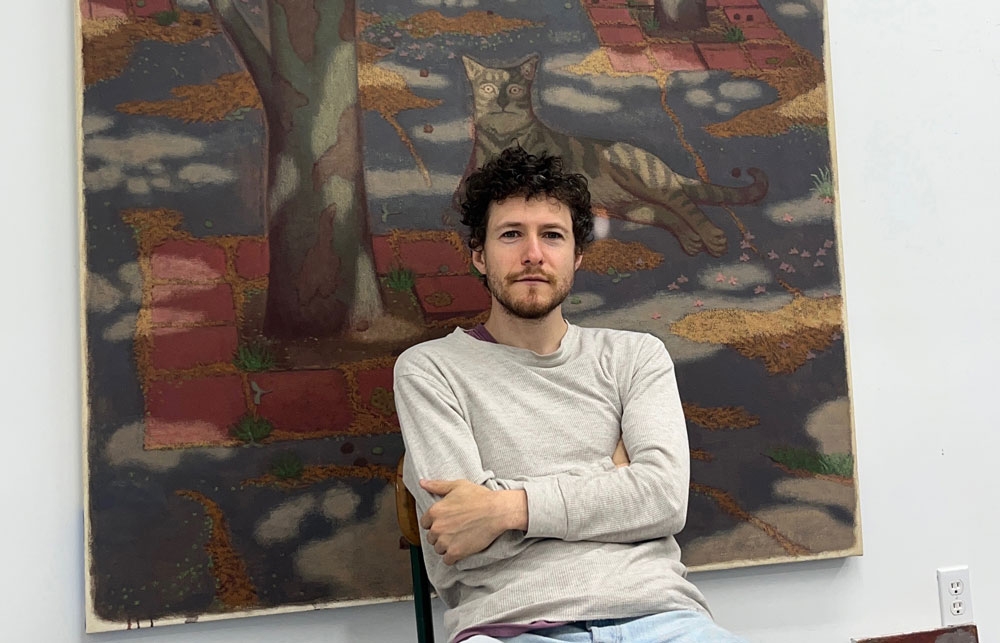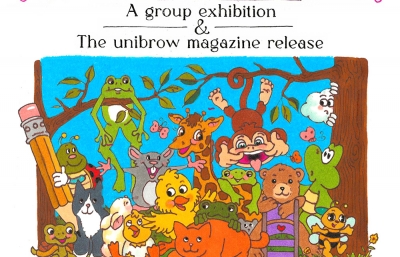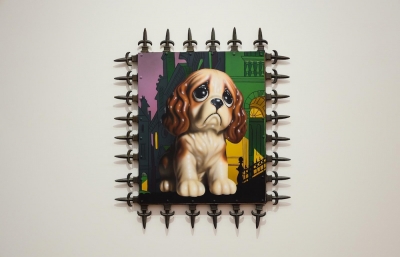Clayton Schiff
A Left Turn at the Far Side
Interview by Evan Pricco // Portrait by Michael Assiff
We rarely know what to do with the absurd, let alone define it. We might say to ourselves, “Oh, life is so absurd,” but indeed, is it just an endless sequence (maybe an array?) of illogical events? Or, in fact, do we simply grow to understand that what is ridiculous is what makes sense. The absurd is what makes the color of life.
In the vivid, surreal landscapes of Clayton Schiff's paintings, there is a curious tug of nostalgia interwoven with what one could only call an aesthetic of fantastical dreams. There is a quietness to the works, an echo of a subconscious trying to come to grips with the mundane incongruity of simple daily tasks and the journeys along the way. His work, while deeply rooted in a personal path, extends an invitation to viewers to explore their own inner dialogues. The elongated forms and expressive features are actually quite funny, suggesting a world teetering between that absurdity and profound revelation. The ordinary becomes, rather, extraordinary. Like Gary Larson but without the subtext, Schiff is a pivotal figure in the world of contemporary art, a mixture of humor and darkness, alienation and anxious loneliness that captures the mood of a post-pandemic globe.

Evan Pricco: I think the first thing I wanted to ask is whether the creatures in your paintings are of the "real world," so to speak. Should we start with reality versus a sort of fantasy?
Clayton Schiff: It’s hard to say for sure. I tend to think of it as one reality over from ours. Everything is built from scratch, not downloaded from our understanding of the lay of this land, but built to some pretty similar specifications. It’s like a kind of fantasy with an often limited capacity for imagination. The confines of our reality find themselves wafting into the fantasy, so a lot of the bleakness just gets amplified on slightly new terms.
This may sound naive, but are there chores, little life nonsense like doing the laundry or sweeping the studio that sort of generate a potential painting? I'm sort of drawn to the activity in each work.
There are indeed. It’s not always clear to me what becomes an idea or image in mind for a painting, but it often can come from activities I engage or observe, generally banal ones like cleaning, eating, working, walking, staring, clipping nails. I’m often drawn to an action that could be ongoing or exist in a loop. Depicting that feels right since it’ll be trapped inside the painting eternally.
There is always this sense of space in each work, like the characters are either alone or quite a bit apart from each other. Walk me through how you construct a scene. What is the genesis, and do you know where you want to go in each work?
The paintings come out of small thumbnail sketches I draw of images or configurations that occur to me throughout the day. Walking around for many hours helps them occur to me. Sometimes I’ll take a picture of something I see and develop it a bit from there. I usually have a sense of where I want each painting to go, but I get the most out of altering and readjusting it throughout the painting’s process. I find that if I go into it with no plan at all, I’m too lost to meaningfully find anything in the painting, and just desperately try to find dry land as soon as any presents itself to me.
There is often a joint process in forming the characters and their surroundings. Usually the figure and ground feel kind of attached to one another, codependent in some way, repeatedly giving and taking. As for the figures’ relations to one another, indeed, there’s a sense of distance kept between them. I think my intent is to hold them in a slightly diagrammatic space, everything pulled apart and slightly out of order. I want to keep the paintings from feeling like snapshots of an action or plausible scenario, but rather like retellings or memories, kind of giving the viewer the constituent parts but not the full synthesis of an occurrence. I think this makes it easier to revisit the scene, and to apply oneself to it, rather than essentially watch something take place.

I'm thinking of the piece, Over There which is on the cover this issue. It possesses a real literary sense, this sort of winding road, the creature with binoculars looking over the landscape. I can't tell if he is longing or at peace. Do you think your characters can find peace with this world?
I think they are seldom at peace. Occasionally they appear happy, but that usually has a bit of a manic or desperate flavor to it. Mostly they’re eaten alive by anxieties, theirs or mine.
The character in this painting is a bit more unknowable to me, but I suspect he’s both longing and at peace. We can’t see what he sees through the window, whether he’s training his sights on a focal point or surveying the ambient beyond, in which he is isolated. What does seem likely to me is that this is a daily ritual, one to which he’s habituated, even if it involves longing for something else.
There are probably a million and more things to be anxious about these days, and on top of that, there is the disquiet of being assessed about one’s stress, as if that permeates literally everything in our world. I was thinking these characters can be projected as us, 100 years in the future, just fully engulfed in some sort of permanent unease?
That seems fair to me, though I’m unclear about the timeline. I do like depicting these fully embodied states, and likely the one that I’ve hit upon most in these paintings is angst. It more than others seems to freeze its hosts.

When did these characters start taking shape for you? And are they the same characters through each show?
Roughly ten years ago. They drifted over from comics and doodles that I used to draw. The characters are usually, but not always, stand-ins for myself. I think that they’re different every time, as they usually arrive through lots of tweaking and the particularities of their surroundings from painting to painting. They’re often the result of their surroundings or whatever mental state they are consumed by. I want the paintings to be both of them and as them. We inhabit their experience, while seeing them from afar in the third person.
I feel like the characters are vulnerable but inhibit a sort of emotional and physical elasticity, as though they could possibly endure more than us, but maybe that’s an optimistic view of them. I can't quite tell.
That sounds right to me. Often they are overly melodramatic embodiments or caricatures of states, feelings, situations, atmospheres. They definitely withstand things more fully than I could, and are more expressive in doing so. I think of it as a slightly optimistic outlook because it lends a cartoonish levity to states that can be otherwise crushing and feel overwhelmingly serious while experiencing them.

The color palette in your show, Routing, at Harkawik earlier in 2024 seemed a bit darker, the mood darker, a little more menacing. Your intent seemed to be quite clear and the colors really emanated this sense of some impending doom. As much as you can speak to it, talk about color and how you’ve embraced this deeply rich palette.
I guess the truly simple reason is that the paintings were mostly made in the winter months. I’ve developed a minor rule for myself that I won’t paint something that is outside of the season it inhabits. I can’t convincingly summon to mind the aura of a season in which we don’t exist. I tried painting overgrown shrubbery that winter and had no feel for it. There was also a lot of doom and gloom on the mind that winter.
As for color in general, I usually just mix batches up somewhat arbitrarily, applying this, not liking that, and then layering until something seems to work. After it undermines itself enough times, it seems to land somewhere that averages all the options and feels right.
Can you tell me if Gary Larson has been an inspiration, or perhaps who else you look to as an influence? I thought I’d read you cited the Coen Brothers, but again, that could be just the mood of the works.
Funny that you should mention Larson because I just started looking at The Far Side again recently. I’d kind of forgotten about it, but I like it so much, the ways that absurdity is so naturalized. It’s not exactly an influence, but I feel like it might as well be, and maybe will become more of one going forward. I’ve looked more to old children’s books like Richard Scarry, William Steig, the D’aulaires, and a lot of post-Impressionist painting lately.

I thought about Larson because he remarked in an interview that, “People try to look for deep meanings in my work. I want to say, 'They're just cartoons, folks. You laugh or you don't.'” I’m not saying your work is humorous, but there is a dark macabre feeling that could almost be looked at as a chance to laugh at our anxiety. Is that a fair assessment?
Yes, I generally do want the paintings to imbue a sense of humor to the many anxieties. And I do think of them often as at least somewhat humorous; though it’s a rare example that would seem to generate a solid laugh. Sometimes I’m also trying to embarrass myself in a way that humor does when it falls flat.
Follow Clayton Schiff at @Claytopia675 and thank you Harkawik and 56 Henry for imagery and support. This interview was originally published in our WINTER 2025 Quarterly edition, available at Shop.Juxtapoz.com.






